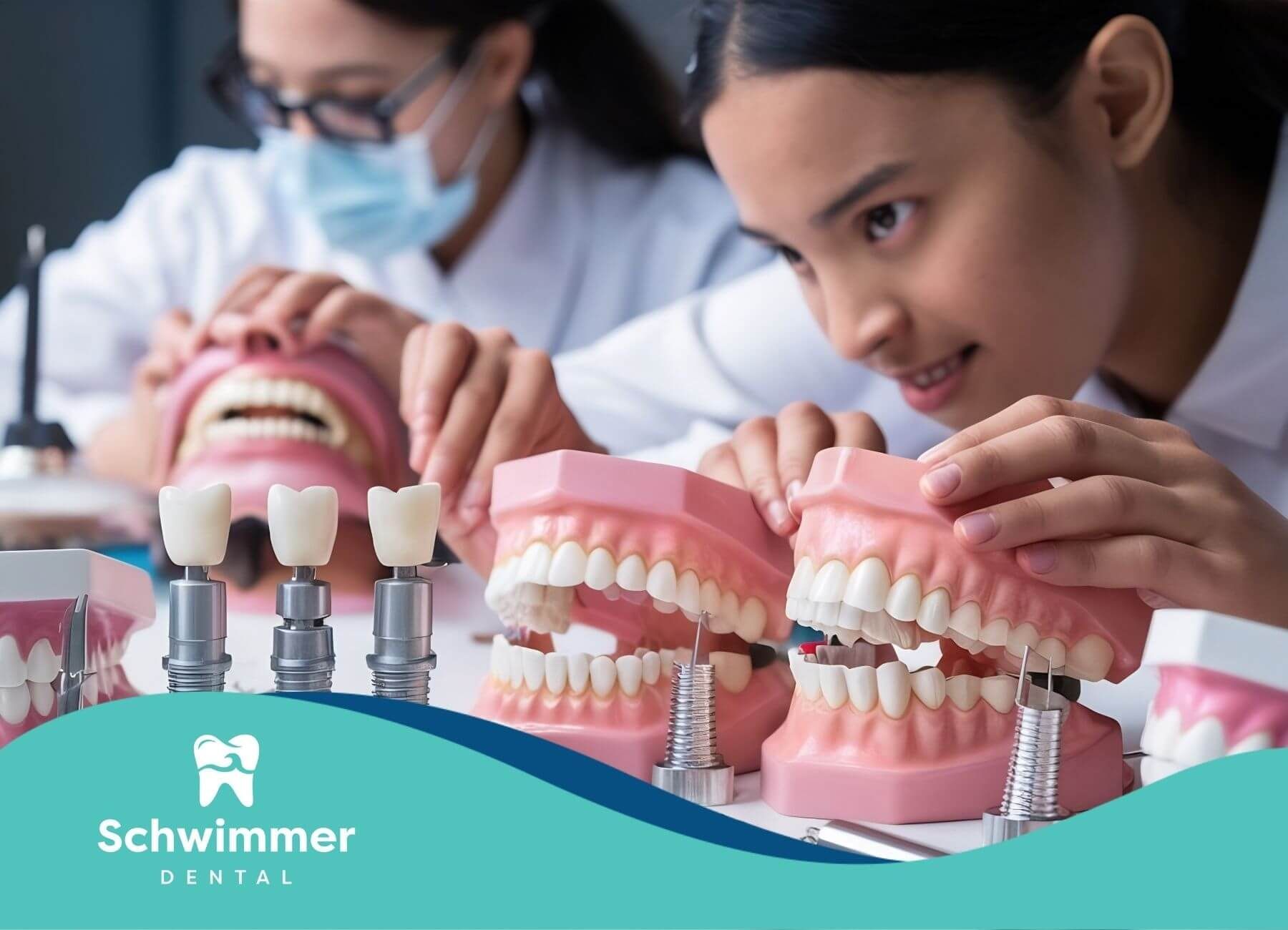The Different Types of Crossbite Patients Should Be Aware Of
Understanding Crossbites
Crossbites are dental conditions where the upper and lower teeth do not align correctly. They can lead to various dental problems if not addressed timely. Here's an overview of the two main types of crossbites: anterior and posterior crossbites.
Anterior Crossbites
Anterior crossbites occur when the lower front teeth overlap the upper front teeth. This misalignment affects about 4 to 5% of individuals. Such cases often require a combination of orthodontic treatments and, in severe instances, surgery to realign the lower jaw.
Key points about anterior crossbites:
- Can cause wear on teeth surfaces.
- May lead to issues with the jaw and overall facial aesthetics.
- Often treated using braces, aligners, or surgical intervention in adults.
- Early intervention in children is crucial to prevent worsening.
For more details on treatment options, see our article on crossbite correction in adults.
Posterior Crossbites
Posterior crossbites are more common, affecting around 16% of people. In this type, the back bottom teeth, including premolars and molars, protrude more than the upper teeth. Treatment usually involves an orthodontic device called an expander, which helps ensure that the upper teeth sit correctly over the lower teeth.
Key points about posterior crossbites:
- Can lead to uneven wear and tear on teeth.
- Often requires early orthodontic intervention.
- Expanders are commonly used to widen the upper jaw.
- Effective in preventing issues like tooth decay and gum disease.
For related information, check out our article comparing crossbite vs overbite.
Comparing Anterior and Posterior Crossbites
| Type | Affected Teeth | Prevalence | Common Treatments |
|---|---|---|---|
| Anterior Crossbite | Front teeth | 4-5% | Braces, aligners, surgery |
| Posterior Crossbite | Back teeth (premolars/molars) | 16% | Expanders, braces |
Addressing crossbites, whether anterior or posterior, is essential for maintaining dental health and preventing long-term complications. For more on crossbite treatment plans, see our section on crossbite treatment options and insights into crossbite in children.
Causes of Crossbites
Understanding the underlying
causes of crossbites is essential for effective treatment and prevention. The primary factors include genetic and developmental influences and dental and skeletal issues.
Genetic and Developmental Factors
Genetics plays a significant role in the development of crossbites. Traits related to teeth alignment and jaw structure are often inherited within families. These genetic tendencies can lead to improper alignment of teeth or jaws, resulting in a crossbite. It is crucial for children to visit an orthodontist by age 7 to monitor and address any developmental issues early on.
Developmental factors also contribute significantly to crossbites. Issues such as thumb sucking, incorrect tongue positioning, and mouth breathing can impact normal jaw growth and teeth eruption. Chronic habits like thumb sucking can push teeth out of alignment, while mouth breathing can affect jaw development.
Dental and Skeletal Issues
Crossbites can stem from a variety of dental and skeletal problems. When one or more permanent teeth do not erupt in their correct position, it can lead to misalignment and the formation of a crossbite. This is often due to problems with the growth and development of the jaw.
Common Causes of Dental Crossbites:
- Improper bone development
- Teeth eruption issues
- Genetic factors
- Thumb sucking
- Incorrect tongue positioning
- Mouth breathing
| Dental Issue | Description |
|---|---|
| Improper Bone Development | Abnormal growth of the jawbones, leading to misalignment. |
| Teeth Eruption Issues | Permanent teeth emerging in incorrect positions. |
| Genetic Factors | Inherited traits affecting jaw structure and teeth alignment. |
| Thumb Sucking | Long-term habit that pushes teeth out of alignment. |
| Incorrect Tongue Positioning | Atypical resting position of the tongue affecting teeth alignment. |
| Mouth Breathing | Breathing through the mouth impacting normal jaw development. |
Understanding these causes can help in early diagnosis and effective treatment planning to prevent future dental complications.
Types of Crossbites
Unilateral Crossbites
Unilateral crossbite occurs when there is a misalignment on one side of the mouth, either in the front or back teeth. This type of crossbite can lead to asymmetrical jaw growth, facial asymmetry, and functional issues such as difficulty biting and chewing on the affected side. Addressing this condition early is crucial to prevent more severe dental complications, particularly in children.
| Factor | Effect |
|---|---|
| Misalignment | One side of the mouth |
| Potential Issues | Asymmetrical jaw growth, facial asymmetry, difficulty biting/chewing |
Bilateral Crossbites
Bilateral crossbite involves the misalignment of the teeth on both sides of the mouth, impacting the bite, jaw alignment, and facial aesthetics. This condition may stem from a narrow upper jaw, a wide lower jaw, or a combination of both, causing problems with proper dental function such as chewing and biting efficiency. Treatment often involves orthodontic solutions like braces or clear aligners to correct the alignment of the upper and lower jaws. For more information on treatment options, see our article on crossbite treatment options.
| Factor | Effect |
|---|---|
| Misalignment | Both sides of the mouth |
| Potential Issues | Bite problems, jaw misalignment, chewing inefficiency |
Both unilateral and bilateral crossbites can have significant implications for dental health. Exploring early and effective crossbite correction in adults and preventative strategies can help mitigate these issues.
Impact of Crossbites
Crossbites can significantly affect dental health and overall well-being. This section covers the potential dental complications and issues related to the temporomandibular joint (TMJ) caused by crossbites.
Dental Complications
Crossbites can lead to a range of dental issues that impact the health of teeth and gums. Among the dental complications associated with crossbites are:
- Uneven Wear Patterns: Misaligned teeth can cause uneven wear on the tooth enamel, leading to increased sensitivity and potential enamel damage.
- Increased Risk of Tooth Decay: The overlapping or misalignment of teeth can make certain areas harder to clean, resulting in a higher risk of cavities.
- Gum Disease: Poor alignment can also lead to gum recession and inflammation, increasing the likelihood of gum disease.
- Misaligned Teeth and Biting Issues: Posterior crossbites, in particular, can lead to difficulties with biting and chewing.
The table below categorizes the specific dental complications and their associated symptoms:
| Dental Complication | Symptoms |
|---|---|
| Uneven Wear Patterns | Increased sensitivity, enamel damage |
| Increased Risk of Tooth Decay | Cavities in hard-to-clean areas |
| Gum Disease | Gum recession, inflammation |
| Misaligned Teeth | Difficulty in biting, chewing issues |
Temporomandibular Joint (TMJ) Issues
Crossbites can contribute to problems associated with the temporomandibular joint (TMJ), which connects the jaw to the skull. Misalignment caused by a crossbite can lead to:
- Jaw Pain and Discomfort: Patients often experience pain in the jaw, which can radiate to the face, neck, and shoulders.
- Clicking or Popping Sounds: This can occur when opening or closing the mouth due to misalignment.
- Jaw Stiffness: Difficulties in moving the jaw freely, leading to problems with speaking and eating.
- Difficulty in Opening or Closing the Mouth: Severe cases may result in limited jaw movement.
Understanding these issues is crucial for seeking appropriate treatment.
Treatment Options for Crossbites
Orthodontic Treatments
Orthodontic treatments are a common approach to correct various types of crossbite. These treatments involve the use of braces, aligners, and expanders to realign the teeth and jaws for a more harmonious bite.
- Braces: Traditional metal braces are highly effective for aligning teeth into their correct positions. They apply continuous pressure over a period of time to shift teeth naturally.
- Invisalign: Clear aligners such as Invisalign offer a discreet alternative to braces. They provide benefits like better aesthetics, fewer doctor visits, and effective crossbite correction with less pain than traditional braces.
- Palatal Expanders: These devices are commonly used for children to widen the upper jaw, allowing the upper and lower teeth to fit together better. They are particularly effective for treating posterior crossbites, which affect about 16% of the population.
- Retainers: Post-treatment retainers help maintain the position of the teeth after the braces or aligners have been removed.
For severe cases of anterior crossbites, which occur in 4 to 5% of people, orthodontic treatment may be combined with surgery to reposition the lower jaw.
Surgical Interventions
In some instances, particularly with adults, surgical interventions may be required to correct crossbites. This can be necessary when facial bone growth is complete, and simpler orthodontic treatments alone are insufficient to achieve the desired results.
- Orthognathic Surgery: This surgical procedure involves repositioning the jaws to ensure they align correctly. It's often used in conjunction with orthodontic treatments to achieve optimal results.
- Dental Compensation: This method involves altering the teeth rather than repositioning the jaw. For instance, it might include using crowns or reshaping teeth to improve their alignment.
Choosing the appropriate treatment often depends on the severity of the crossbite and the age of the patient. Early diagnosis and treatment can be crucial, especially in children, to prevent more complex issues in the future.
Table: Common Treatments for Crossbite
| Treatment Type | Suitable For | Advantages | Considerations |
|---|---|---|---|
| Braces | Children, Teens, Adults | Highly effective | Visible, requires regular adjustments |
| Invisalign | Teens, Adults | Discreet, removable | May not be suitable for severe cases |
| Palatal Expanders | Children | Corrects jaw width | May cause discomfort initially |
| Orthognathic Surgery | Adults with severe crossbite | Permanent correction | Invasive, requires recovery time |
Preventative Measures for Crossbites
Preventative measures play a critical role in managing and mitigating crossbites, safeguarding against potential complications. Understanding and implementing these measures can help individuals and families prevent long-term dental issues associated with crossbites.
Early Diagnosis and Treatment
Early diagnosis is pivotal in addressing crossbites effectively. Dental experts recommend that children see an orthodontist starting at age 7 to monitor the growth of their adult teeth and address any potential issues early on. Monitoring from a young age helps in identifying problems while they are still manageable.
Diagnosing and treating crossbites early can prevent asymmetrical jaw growth, facial asymmetry, and the need for complex treatments in adulthood. Parents and caregivers should consider scheduling regular orthodontic check-ups for early detection.
| Age Group | Recommended Action |
|---|---|
| Under 7 Years | Regular dental check-ups |
| Age 7 | First orthodontic assessment |
| Ongoing | Annual orthodontic evaluations |
Habit Correction Strategies
Certain habits can contribute to the development of crossbites. Identifying and correcting these early can help prevent the condition from worsening. Key habits to watch for include thumb sucking, incorrect tongue positioning, and mouth breathing.
To address these habits:
- Thumb Sucking: Discourage thumb sucking through positive reinforcement and, if necessary, consult with a pediatric dentist for advice on corrective measures.
- Incorrect Tongue Positioning: Tongue thrusting can be managed with the help of a speech therapist who can guide exercises to correct tongue placement.
- Mouth Breathing: This may indicate underlying issues such as allergies or nasal obstructions. An ENT specialist can help identify and treat these conditions.
By staying vigilant and proactive, individuals and families can significantly reduce the risk of developing severe crossbite complications. Regular dental check-ups and habit correction form the foundation of effective preventative care.
SOURCES:
https://www.webmd.com/oral-health/what-to-know-about-crossbite
https://en.wikipedia.org/wiki/Crossbite
https://www.ncbi.nlm.nih.gov/books/NBK499873/
https://www.healthline.com/health/crossbite#definition
https://www.colgate.com/en-us/oral-health/adult-orthodontics/crossbite-correction-how-to-straighten-your-smile



